
Mobile trommel screen are flexible screening equipment, equipped with a rotating drum screen surface and mounted on a vehicle or tracked chassis. Material enters the drum and is graded by screens of varying apertures as the drum rotates, achieving coarse and fine separation. Their ease of movement makes them suitable for outdoor applications such as mining and construction waste, enabling quick switching between locations and improving screening efficiency.
The mobile trommel screen is a highly efficient separation device that integrates screening and mobility. It is widely used in a variety of applications, including mining, construction waste recycling, and sand and aggregate processing. Its flexibility and convenience make it an ideal choice for outdoor screening operations.
The core of the equipment consists of a mobile carrier, a rotating drum, a drive system, and auxiliary screening structures. Mobile carriers are available in two types: tire-mounted and track-mounted. The vehicle-mounted type is suitable for road transport and allows for rapid relocation; the track-mounted type is adaptable to complex terrain, such as muddy and mountainous areas, and has strong climbing capabilities. The rotating drum is a key screening component. The inner wall of the drum is equipped with lifting plates, and screens with different apertures, ranging from a few millimeters to tens of millimeters, are installed in sections as needed to achieve multi-level material separation.
In operation, the drive motor drives the drum at a low speed through a reducer. Material enters the drum from the feed hopper and is continuously moved forward by the lifting and tilting action of the lifting plates. Material smaller than the screen aperture falls through the mesh, while material larger than the aperture is discharged from the end of the drum, completing the coarse and fine classification. Compared with fixed screening equipment, mobile trommel screen do not require on-site infrastructure and can be put into use upon arrival, significantly saving installation time. They can also accurately connect to the raw material production area, reducing material transportation costs. When combined with auxiliary components such as dust removal and impurity removal, they can also improve screening quality and adapt to a variety of material processing needs.
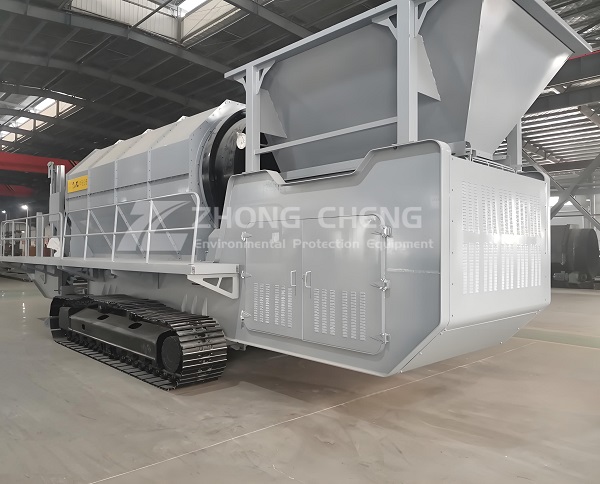
1. Select a mobile carrier based on the terrain. Prioritize the type of carrier based on site conditions: For road transfers or hardened surfaces, choose a tire-mounted vehicle, which offers fast transfer speeds and low costs. For complex terrain such as mountainous areas, muddy terrain, and mining areas, choose a tracked vehicle, as its tracks offer strong grip, better adaptability to climbing slopes and surfaces, and reduce the risk of getting stuck.
2. Determine the drum and screen based on material characteristics. Select core components based on material particle size, hardness, and viscosity: select a small-aperture screen (≤5mm) for fine-grained materials and a large-aperture screen (≥10mm) for coarse aggregates. For sticky materials, confirm the design of the drum's inner wall skimmer, preferably one with a cleaning device, and ensure that the screen can be quickly removed and replaced.
3. Verify the power and stability of the drive system. The drive system directly affects efficiency, so the power should be selected to match production capacity: for processing 10-30 tons per hour, choose a 15-22kW motor; for processing over 30 tons, choose a 22-45kW motor. Also, confirm whether the machine has a speed reducer and variable frequency drive function. Variable frequency drives offer adjustable speeds to accommodate different material screening requirements.
4. Pay attention to screening accuracy and auxiliary configurations. If high grading accuracy is required, choose a multi-segment screen drum to ensure a reasonable aperture gradient within each segment. For high dust loads, install a pulse dust removal device to reduce pollution. For sticky materials, add a vibrating screen cleaner to prevent screen clogging and affect efficiency.
5. Consider equipment compatibility and flexibility. Choose equipment size based on site space, prioritizing compact models for confined areas. Confirm whether the feeding method is compatible with existing conveying equipment, such as belt conveyors or loaders. Also, verify whether components such as screens and skimmers can be customized to meet individual needs.
6. Evaluate the brand and after-sales service capabilities. Prioritize reputable brands and verify the material quality assurance of core components such as drums and screens. Confirm whether on-site installation and commissioning, as well as the supply of wearing parts, are provided. Inquire about fault response speed. In remote areas, choose brands with local service points to minimize downtime and maintenance.
The machine is welded with wear-resistant steel and features a high-toughness screen material, making it resistant to deformation and breakage. The track/tire carrier provides strong load-bearing capacity, and the drive system features a high-quality motor with overload protection. The machine body is corrosion-resistant and rust-resistant, and its accessories are highly adaptable, ensuring long-term stable operation and a long maintenance cycle.
The drum length and screen aperture are tailored to the material grading requirements; the carrier can be either tire-mounted or track-mounted to suit the terrain. Dust removal and screen cleaning accessories can be added, drive power can be flexibly adjusted, and the machine size can be adjusted to suit the site.
The drum features adjustable speed and multiple precision screens for high grading efficiency. The drive system is powerful and stable, adaptable to materials of varying hardness. Screen cleaning and dust removal accessories reduce clogging, and the multi-terrain carrier ensures continuous operation with minimal malfunctions.
Tire or track-mounted carriers adapt to various terrains, allowing for easy relocation without the need for infrastructure. Multiple screen sections can be configured as needed for precise grading. Drive and screen cleaning accessories adapt to a wide variety of materials, ensuring high efficiency. The flexible structure allows for easy integration with other equipment, resulting in low maintenance costs.
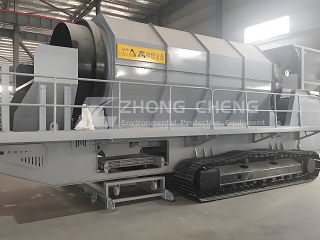
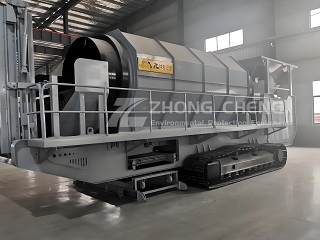
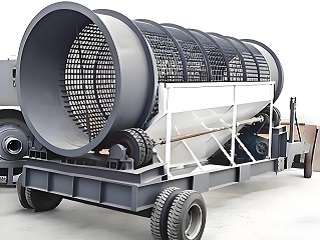
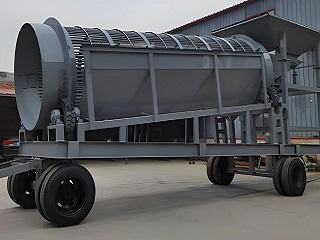
The efficient screening of mobile trommel screens relies on a coherent mechanism of "power drive - material conveying - classification and separation - auxiliary support." This core process revolves around the rotating drum and the coordinated operation of multiple systems. The specific process is as follows:
1. Power Supply and Drum Drive
After the equipment is started, the variable frequency motor, acting as the power source, outputs kinetic energy, which is transmitted via a coupling to a reducer. This high-speed rotation is converted into the low-speed, high-torque required by the drum (typically 10-15 rpm), ensuring a stable screening process and sufficient power. This adjustable speed drive design is key to its adaptability to different materials. Hard materials can be processed at a lower speed to enhance torque, while fine materials can be processed at a higher speed to improve efficiency. Furthermore, an overload protection device is simultaneously activated, instantly shutting off power in the event of a material jam, ensuring equipment safety. 2. Material Conveying and Internal Movement
The material to be screened enters the drum at a uniform speed through the feed hopper. The drum is installed at an angle of 3°-5°, and the curved lifting plates on the inner wall enable orderly movement. As the drum rotates, the lifting plates repeatedly lift and drop the material, preventing accumulation while ensuring sufficient contact with the screen mesh. The tilt guides the material slowly along the axial direction toward the discharge end, creating a continuous screening flow.
3. Core Screening and Grading Process
The drum is equipped with screens of varying apertures in axial sections, forming multi-stage screening zones. During this dropping and movement of the material, particles smaller than the screen aperture pass through the mesh and fall into the corresponding collection hopper, while particles larger than the aperture continue on to the next screening stage. Ultra-coarse material that fails to pass through all the screens is discharged from the final discharge port, achieving precise grading from coarse to medium to fine, directly reflecting the high performance of the multi-stage precision screen mesh. 4. Auxiliary Guarantees Improve Efficiency
To address clogging issues, the screen cleaning device uses high-frequency vibration to shake off debris from the screen. A dust removal accessory absorbs dust, optimizing the working environment. Tracked or tire-mounted mobile carriers ensure stable support on various terrains, providing a foundation for continuous drum rotation, significantly reducing the risk of downtime and fully demonstrating their high performance advantages.


| Model | Sieve Mesh Size (mm) | Processing Capacity (t/h) | Power Configuration (kw) | Sieving Accuracy | Drum Speed (r/min) | Machine Weight (kg) |
|---|---|---|---|---|---|---|
| MDS-300 | 3-10 | 30-50 | 15 | 5-50mm | 20 | 2500 |
| MDS-500 | 5-15 | 50-80 | 18 | 5-50mm | 18 | 3500 |
| MDS-700 | 8-25 | 70-100 | 22 | 10-100mm | 15 | 4500 |
| MDS-1000 | 10-30 | 100-150 | 30 | 20-100mm | 12 | 6000 |
| MDS-1500 | 12-50 | 150-200 | 45 | 50-200mm | 10 | 8500 |
| MDS-2000 | 15-60 | 200-300 | 55 | 50-200mm | 8 | 12000 |
*The output will vary according to different materials, feed particle size and other factors.
Save Time! Get A Detailed Quotation Quickly.
